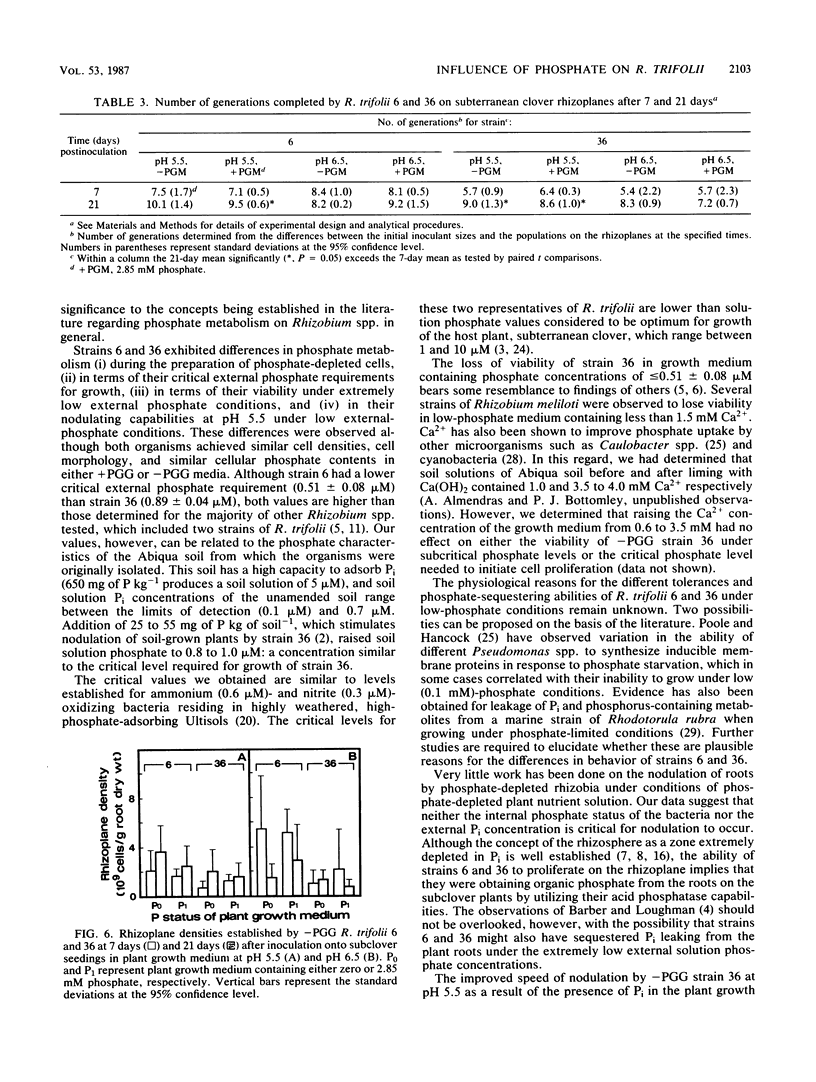Abstract
The growth and nodulating characteristics of Rhizobium trifolii 6 and 36 differed under different external phosphate conditions. Under growth conditions designed to deplete the internal phosphate content of the rhizobia, strain 6 maintained a generation time of 5 h during the exponential phase over two cycles of growth in phosphate-depleted medium. In contrast, the generation time of strain 36 was extended from 3.5 to 9.8 h over two cycles of phosphate-depleted growth, although the organism eventually achieved the same cell density and cellular phosphate content as that of strain 6 at stationary phase. Phosphate-depleted strain 6 required 0.51 ± 0.08 μM phosphate to commence proliferation, whereas phosphate-depleted strain 36 required 0.89 ± 0.04 μM phosphate under the same conditions. Phosphate-depleted strain 6 maintained viability when exposed to external phosphate concentrations subcritical for growth to occur, whereas phosphate-depleted strain 36 lost viability within 48 h when exposed to medium containing phosphate at concentrations subcritical for growth. Phosphate-depleted strain 36 was inferior to phosphate-depleted strain 6 at nodulating subterranean clover (Trifolium subterraneum L. cv. Mt. Barker) by taking 2 to 4 days longer to develop nodules in phosphatedepleted plant grown medium at pH 5.5. Nodulation by phosphate-depleted strain 36 was accelerated either by including phosphate in the plant growth medium at pH 5.5 or by raising the solution pH of phosphate-depleted plant growth medium to pH 6.5. External phosphate and pH effects were not observed on the nodulating capabilities of phosphate-depleted strain 6 or on luxury phosphate-grown cells of either strain. Phosphatedepleted strains 6 and 36 proliferated to a similar extent on the rhizoplanes even under stringently low external Pi concentrations. The phosphatase activities of both phosphate-depleted strains were significantly (P = 0.05) higher at pH 6.5 than at pH 5.5, and the activity of strain 6 was significantly higher (P = 0.05) than that of strain 36 at pH 5.5 and 5.0.
Full text
PDF







Selected References
These references are in PubMed. This may not be the complete list of references from this article.
- Almendras A. S., Bottomley P. J. Influence of Lime and Phosphate on Nodulation of Soil-Grown Trifolium subterraneum L. by Indigenous Rhizobium trifolii. Appl Environ Microbiol. 1987 Sep;53(9):2090–2097. doi: 10.1128/aem.53.9.2090-2097.1987. [DOI] [PMC free article] [PubMed] [Google Scholar]
- Beck D. P., Munns D. N. Phosphate Nutrition of Rhizobium spp. Appl Environ Microbiol. 1984 Feb;47(2):278–282. doi: 10.1128/aem.47.2.278-282.1984. [DOI] [PMC free article] [PubMed] [Google Scholar]
- Demezas D. H., Bottomley P. J. Autecology in Rhizospheres and Nodulating Behavior of Indigenous Rhizobium trifolii. Appl Environ Microbiol. 1986 Nov;52(5):1014–1019. doi: 10.1128/aem.52.5.1014-1019.1986. [DOI] [PMC free article] [PubMed] [Google Scholar]
- Demezas D. H., Bottomley P. J. Interstrain Competition between Representatives of Indigenous Serotypes of Rhizobium trifolii. Appl Environ Microbiol. 1986 Nov;52(5):1020–1025. doi: 10.1128/aem.52.5.1020-1025.1986. [DOI] [PMC free article] [PubMed] [Google Scholar]
- Dughri M. H., Bottomley P. J. Effect of Acidity on the Composition of an Indigenous Soil Population of Rhizobium trifolii Found in Nodules of Trifolium subterraneum L. Appl Environ Microbiol. 1983 Nov;46(5):1207–1213. doi: 10.1128/aem.46.5.1207-1213.1983. [DOI] [PMC free article] [PubMed] [Google Scholar]
- Kingsley M. T., Bohlool B. B. Release of Rhizobium spp. from Tropical Soils and Recovery for Immunofluorescence Enumeration. Appl Environ Microbiol. 1981 Aug;42(2):241–248. doi: 10.1128/aem.42.2.241-248.1981. [DOI] [PMC free article] [PubMed] [Google Scholar]
- Poole K., Hancock R. E. Phosphate-starvation-induced outer membrane proteins of members of the families Enterobacteriaceae and Pseudomonodaceae: demonstration of immunological cross-reactivity with an antiserum specific for porin protein P of Pseudomonas aeruginosa. J Bacteriol. 1986 Mar;165(3):987–993. doi: 10.1128/jb.165.3.987-993.1986. [DOI] [PMC free article] [PubMed] [Google Scholar]
- Throneberry G. O. Phosphorus and zinc measurements in Kjeldahl digests. Anal Biochem. 1974 Aug;60(2):358–362. doi: 10.1016/0003-2697(74)90242-5. [DOI] [PubMed] [Google Scholar]


